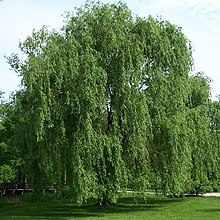| Willow Temporal range:
| |
|---|---|

| |
| Salix alba 'Vitellina-Tristis' Morton Arboretum, Lisle, Illinois | |
| Scientific classification | |
| Kingdom: | Plantae |
| Clade: | Tracheophytes |
| Clade: | Angiosperms |
| Clade: | Eudicots |
| Clade: | Rosids |
| Order: | Malpighiales |
| Family: | Salicaceae |
| Subfamily: | Salicoideae |
| Tribe: | Saliceae |
| Genus: | Salix L., nom. cons.[1] |
| Type species | |
| Salix alba | |
| Diversity[2] | |
| About 350 species | |
Willows, also called sallows and osiers, of the genus Salix, comprise around 350 species (plus numerous hybrids) of typically deciduous trees and shrubs, found primarily on moist soils in cold and temperate regions.
Most species are known as willow, but some narrow-leaved shrub species are called osier, and some broader-leaved species are referred to as sallow (from Old English sealh, related to the Latin word salix, willow).
Some willows (particularly arctic and alpine species) are low-growing or creeping shrubs; for example, the dwarf willow (Salix herbacea) rarely exceeds 6 centimetres (2+1⁄2 in) in height, though it spreads widely across the ground.
- ^ Cite error: The named reference
IPNI_325916-2was invoked but never defined (see the help page). - ^ "Salix L." Plants of the World Online. Royal Botanic Gardens, Kew. Retrieved 28 December 2022.